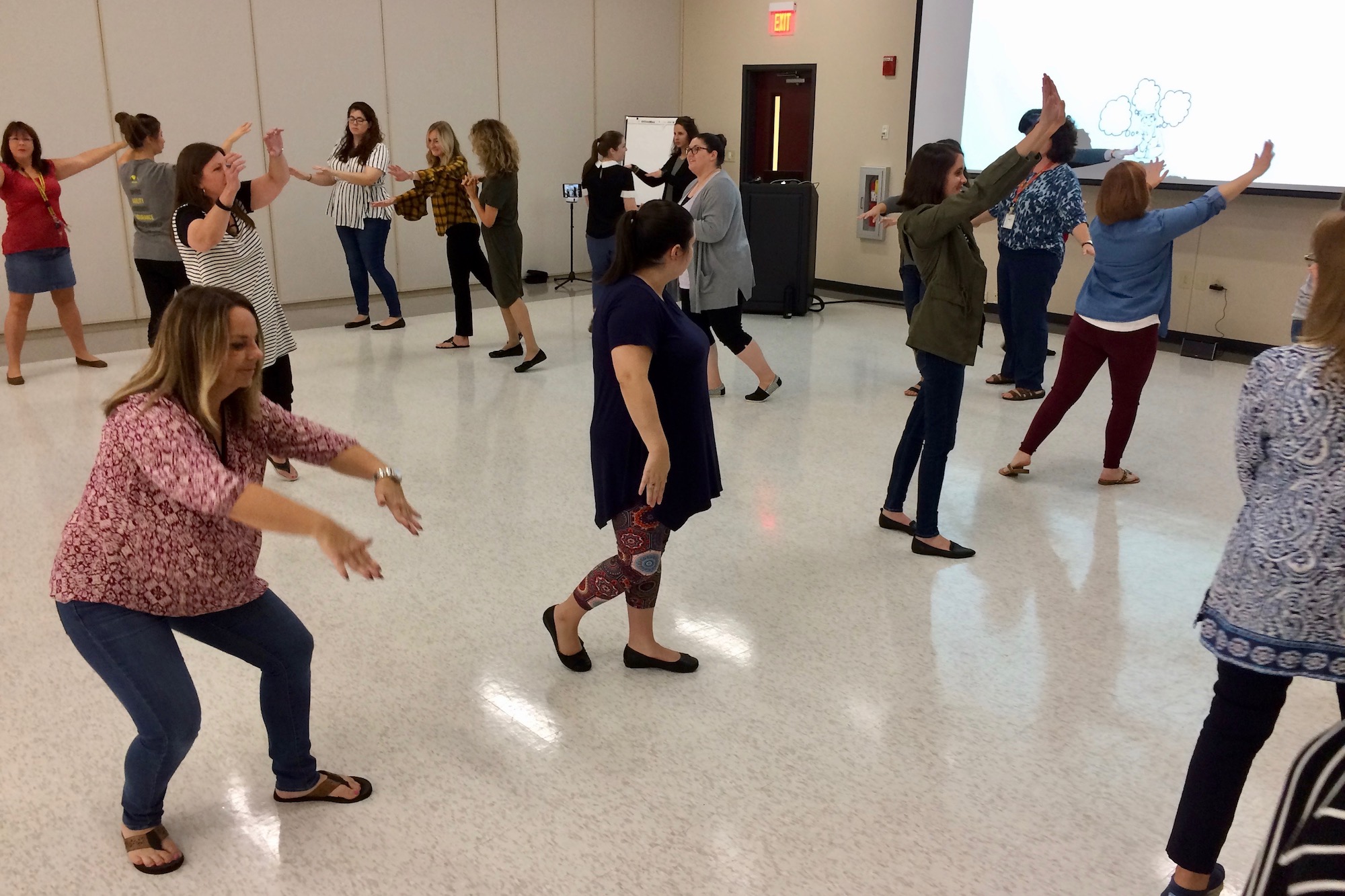Local teachers learn arts integration at CECA professional development workshop
(Posted Oct. 18, 2018; video above by CMCSS)
A couple of the grade school teachers held their hands overhead, their fingers dancing. Three other teachers squatted, kneeled or sat, waving their arms back and forth slowly.
In their slow dance, the teachers emulated stars twinkling over slowly moving mountains. In doing so, they were practicing arts integration, an approach to teaching various subjects, such as science, through art, such as dance.
More than 20 teachers attended an arts integration professional development workshop Oct. 2 at the Clarksville-Montgomery County School System’s Central Services-South building. Austin Peay’s Center of Excellence for the Creative Arts paid for the workshop, led by John F. Kennedy Center for the Performing Arts teaching artist Randy Barron.
“One thing about this approach (the workshop’s arts integration focused on dance) is movement is a very direct communication,” Barron, a choreographer and former professional ballet and modern dance performer, said. “We can put a lot of information into a short period of time and a short amount of movement that can be very complex, very dense.”

“What we’re trying to do is connect language and movement today and show how we can say a lot,” Barron said. Arts integration is “an approach to teaching, a way of looking at teaching. It’s not really a program, it’s not something you provide materials for. It’s a way of thinking.”
According to the Kennedy Center, arts integration is “an approach to teaching in which students construct and demonstrate understanding through an art form. Students engage in a creative process which connects an art form and another subject area and meets evolving objectives in both.”
In the above mountain-and-stars dance, students can learn language associated with geology and astronomy.
But the art doesn’t have to be dance.
“Sometimes, for instance, when I’m teaching a social studies unit, I might not go to dance when it has to do with specific events in history, or a date,” Barron said. “I might choose theater or music or painting.”
Arts integration helps students actively build understanding by experiencing the ideas they’re learning and by collaborating, reflecting and problem-solving with others. Arts integration also can energize teachers and their classroom.

Barron put the teachers into motion, first by having them give meaningful movement to action words (such as leaping), modifiers (such as walking heavily) and nouns (such as being a stream).
When the teachers became streams, they stood while winding their arms to and fro.
“Scientifically, there was something wrong with your streams,” Barron said. “You were standing on the bank, watching the stream go by,” he said. “You need to BE the stream.”
He demonstrated by winding his arms and his body around the room.
Barron then broke the teachers into groups and gave them three minutes to choreograph a dance of mountains and stars, specifically to this poem:
Beneath the stars,
The mountains dance
Their slow dance.
Students, in a similar exercise, could learn such things as the words associated with mountains and stars (figurative and scientific); dance and choreography improvisation; and how good stories have a beginning, a middle and an end.
“The language connection keeps happening over and over,” Barron said.
Austin Peay’s Center of Excellence for the Creative Arts (CECA) paid to fly in Barron and for the substitute teachers needed to teach classes while the regular teachers attended the workshop. Barron also gave arts integration demonstrations at local schools.
The money came from a generous 10-year gift from the Heydel Family Foundation, in honor of June Heydel, said Dr. Janice Crews, CECA director.
“The gift will support professional learning for teachers and teaching artist residencies like what occurred this week … through the Kennedy Center’s Partners in Education program,” Crews said. “It will also pay for tickets and transportation for students to experience the arts.”
That includes CECA paying for tickets and transportation so fifth-graders can attend an educational show, at Roxy Regional Theatre, for example.
“We’re very lucky to have that funding to do these types of things,” Crews said.
To support CECA and other APSU fundraising initiatives, call the Office of University Advancement at 931-221-7127.